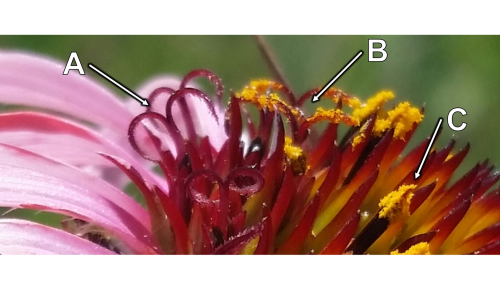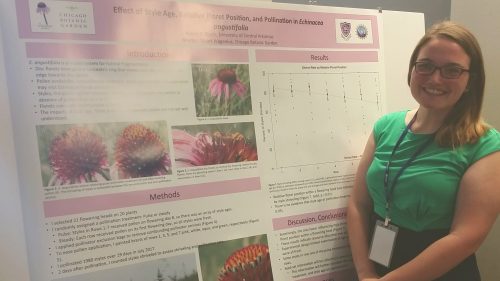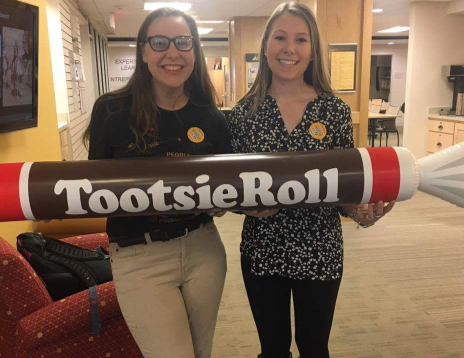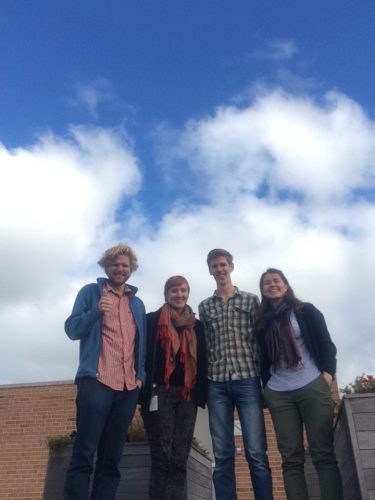|
|
Wes presented the poster “Attaining high species diversity in prairies with low initial restoration investment” at the 85th Winchell Undergraduate Research Symposium & 31st MAS Annual Meeting with Stuart as co-author at the University of St. Thomas, St. Paul, MN on 21 April 2018. Here’s the poster.
Yay, Wes!
 Wes presents his poster.
Hi everyone! Tracie, Kris (another PBC grad student), and I had a great time presenting this year at the Midwest Ecology and Evolution Conference in Kalamazoo, MI. Here’s a look at my poster that I presented about pollen on Echinacea as a part of the ongoing Floral Neighborhood Communities project:
 Do pollen loads differ among native bee visitors to Echinacea angustifolia?  A picture of me presenting! MEEC 2018 was awesome! For any undergrad or graduate student interested in attending an inexpensive, regional conference I would highly recommend it. It was great to network with fellow graduate students and hear all about the great research ongoing here in the region!
Hello, Nina here! These past few months, I was an extern with the Echinacea project, looking specifically at data collected last summer about Echinacea success and surrounding plant diversity. My findings are summarized in the report that I’ve attached here.
Ashely Barto, an REU student in summer 2017, developed an independent project looking at how pollination influences reproductive success in Echinacea angustifolia. She was interested in how heads that get pollinated each day differ from heads that only get visited infrequently, but receive a lot of pollen on those sporadic visits.
Over 19 days in July 2017, 1980 styles from 21 capitula were pollinated following a randomly assigned pollination schedule: pulse or steady. Capitula assigned to the pulse pollination treatment received pollen on all emergent styles at the same time, so there was a range of style ages. Steady pollination capitula received pollen daily, so all styles were pollinated on the day they emerged. Style shriveling, a proxy for pollination, was used as the response variable.
Using a generalized linear model, interactions between style age, floret position, and pollination treatment were considered to create a pollination rate model. Style age and pollination treatment did not interact or have an additive effect on pollination rates. Instead, floret position within the capitulum was the only factor essential to modeling pollination rates in Echinacea. The results suggest resource allocation plays a major role in Echinacea reproduction. Ashley will investigate seed set from the same capitula later this year to further elucidate the role of style age, floret position, and pollination treatments in Echinacea reproduction.
 Echinacea on its third day flowering. Within the disc florets, there are persisting styles in Row 1 (A), fresh styles in Row 2 (B), and new anthers in Row 3 (C).
Ashley presented her work at the 2017 Arkansas INBRE Conference on October 28. Arkansas INBRE is the Arkansas Institutional Development Award’s network of biomedical research conference, and this year, it was hosted at the University of Arkansas. While this conference attracted undergraduates from many states to present on biomedical research in biology, chemistry, and physics, there were many posters like Ashley’s sharing summer research outside of the medical scope central to the conference’s theme. Ashley was able to talk about the Echinacea Project’s big picture work and how her independent REU Project fit into that larger image.
 Ashley presenting her summer REU project at the Arkansas INBRE Conference in October 2017. Start year: 2017
Location: Nice Island, prairie remnant
Physical specimens:
- 21 harvested Echinacea heads at the CBG, ready for cleaning and x-ray
Products: Here’s Ashley’s Poster of her results.
Christopher Lortie presents ten simple rules for successful short and swift presentations in this PLOS Computational Biology paper.
10 simple rules:
1. Plan a clear story
2. Provide only one major point per slide
3. Limit use of text
4. Use simple visuals
5. Develop a consistent theme
6. Repeat critical messages twice using different visuals
7. Use the principle of parsimony in explanations
8. Allocate more than one slide to effectively end the narrative
9. Use the final slide for contact information and links to additional resources
10. Use timed practice
Read the article.
Hey guys! Long time no flog!
Remember back in June when Leah and I started working on our Independent Study Theses for The College of Wooster? Well, we finished! If you can remember that far back, I was examining the effect of removing buckthorn on the edge of a bog. I found that soil pH and canopy cover change after just a month of buckthorn removal – more similar to that of the bog interior! Leah found that bees exhibit decreasing floral fidelity towards Echinacea over time! So interesting!!!
We love and miss the beautiful Minnesota and our amazing pals in Team Echinacea so much! Thanks for everything, guys. We couldn’t have done it without you.
Love,
Alyson & Leah
 Me and Leah holding our Tootsie Roll, a Wooster tradition in honor of finishing our thesis!
We’re done! Yesterday Emma and I finished up our poster with mere minutes to spare and some timely help from Stuart (the man knows concise language). I thought of about five other tests that we should run (to characterize interactions between explanatory variables, etc) while wrapping up our last section, but defeated the urge. We’re both very proud of the poster and the work we did these past three weeks.
Thanks to everyone in the Echinacea Project for your guidance, help, and companionship! This externship has been an awesome experience and has definitely helped us to grow as scientists.
Here’s a link to our final poster:
Kropp_Stewart_Poster
Part 1. I couldn’t stay away from the Echinacea Project too long. As I’m positive you want to hear both about my poster that I will be presenting at MCMS tomorrow at the University of Chicago and my adventures in Chicago, I will share both. As I arrived at the airport to fly to Chicago, I realized I had forgotten my cell phone. I thought to myself, I lived most of my life without a cell phone, I can do it another day. After arriving in Chicago, I had thankfully packed a dollar in quarters, so I was able to use a pay phone (yes, those still exist) to call a cab. While I did struggle to understand the technology, I was finally able, after spending my only dollar in quarters, to procure transportation to the Chicago Botanic Gardens. I was left penniless, phoneless, and with only a laptop and my knowledge of Chicago (this, by the way, was absolutely nil). After making a successful rendezvous with the team, I enjoyed a lunch and tour of the lab. It was great to see everyone again.
Part 2. After figuring out the best way to get to my destination at the University of Chicago, I jumped on the purple line, confident that, after a quick jaunt on the green line, all I’d have to do was walk a block or two to the hotel, where dinner awaited me. I hopped off the train, and quickly realized that the area had been highly developed since the last google street image had been taken, unless my memory of the picture failed me. Ah well, I thought, I wrote down the street that will get me to my hotel, it’s just east of here. The street just east was not the correct street. Maybe the map I saw was just wrong. By the next street, I knew I was in the wrong place. Thankfully a friendly man suggested a bus that would take me five miles to the east, where I thought I was getting off. Yes, I had taken the wrong train. All was well and good until I hopped on the bus and realized that I was penniless, with no money for a fare. Again, the bus driver was a greatly friendly man, and I rode the bus without a fare. Sailing was smooth from there on out.
Tomorrow I will present my findings on how edge effects play a role in the style persistence and pollen limitation of Echinacea at the Midstates Consortium for Math and Science. Style persistence decreased as plants were farther from habitat edges, demonstrating a spatial pattern in pollination. Attached is my poster. stylepersistenceedgeposter
Off to share a room with someone I haven’t met yet. Day in the life.
 No explanation needed. Great to see y’all again.
Hi Flog,
It’s great to be back in Minnesota after a muggy and fun week at ESA in Ft. Lauderdale. On Thursday, I presented my poster, “Two temporal scales of reproduction affect mating opportunity in long-lived perennials.” The poster was displaying work that I did this past year looking at the 11-year phenology dataset we have from the individuals in p1. The question I tried to answer, basically, was whether it flowering on a high-flowering day or in a a high-flowering year was more important for an individual’s number of opportunities to mate. For example, this year is a low-flowering year in p1, whereas last year was a high-flowering year. Would it be better to flower on the population’s peak date of flowering this year or to have flowered off peak last year? It turns out that in this system, the year is more important relative to the day. I think this is because all flowering within a season is synchronous enough that most individuals don’t totally miss out on opportunities to mate, even if they are early or late flowering. I still have some work left to do on my analysis, but it was super helpful to hear what questions people had and get some useful insights as well!
 Here’s me with my poster
Here’s a link to my poster if you want to take a closer look!
Hi Flog!
I’m sitting in Greater Fort Lauderdale/Broward County Convention Center, taking a break from hearing about all the great work people from all over the place have been doing. I thought that this was a good time to update you on how my poster presentation went (Mostly because the convention center has free wifi and our hotel doesn’t. What?! how can it be 2016 and there not be free wifi…)!
I arrived in lovely* Fort Lauderdale Sunday afternoon, this is the first conference I have been to and It is a little overwhelming but also super exciting! I presented my poster on “The heritability of flowering time and duration in Echinacea angustifolia” last night (Monday). Lots of people stopped by and it was really fun getting to explain all of the work I had done over the past year to them. The poster session lasted for 2 hours but it felt like 15 minutes.
Amy is here with me and she is going to be presenting her poster on Thursday night!
*Lovely – 90 percent humidity and 90 degrees
Below is a link to a PDF of my poster for closer inspection!
esaposter_willreedvf-1-1-1
|
|








